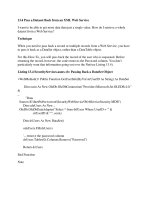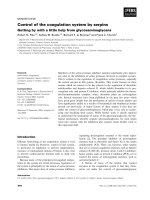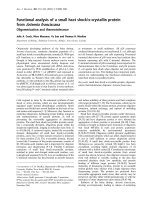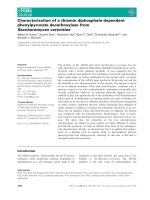PAUL HASTINGS STAY CURRENT: A CLIENT ALERT FROM PAUL HASTINGS potx
Bạn đang xem bản rút gọn của tài liệu. Xem và tải ngay bản đầy đủ của tài liệu tại đây (1.02 MB, 5 trang )
1
The Rise of Covered Bonds?
BY JOHN DOUGLAS, ERICA BERG AND KEVIN PETRASIC
On July 15, 2008, in the wake of the failure of
Indymac Bank – one of the largest bank failures in
history – and a mounting cloud of uncertainty
enveloping the banking industry, the Federal
Deposit Insurance Corporation (“FDIC”) issued its
Final Covered Bond Policy Statement (“Final
Policy Statement”). In a move many view as an
effort by the FDIC to bolster the mortgage market
and provide banks with a new liquidity tool (and
funding alternative to the struggling securitization
market), the Final Policy Statement may open the
way to a U.S. market in covered bonds. Though
covered bonds have existed and flourished in
European markets, a U.S. market for these bonds
has faced regulatory uncertainty making
depository institutions hesitant to participate. The
Final Policy Statement alleviates some of these
concerns in an attempt to invite more players to
the market.
What is a Covered Bond?
A covered bond is a debt security issued by a
depository institution and backed by an identifiable
pool of mortgage loans over which the covered
bondholders have recourse. In the event of the
insolvency of the issuing bank, the pool of
mortgage loans, or “cover pool,” serves to satisfy
the covered bond debt, and is separate and
distinct from the issuer’s other assets. Unlike
traditional mortgage securitizations, covered bond
issuers maintain the mortgage loans on their
balance sheets and retain the risk of loss with
respect to the pool of mortgage loans. In contrast,
securitizations are structured to transfer the risk
from the bank at the time of the issuance of the
securities (although this has numerous caveats, as
we have seen over the past year), and the assets
are transferred to a special purpose vehicle
(“SPV”). While security holders of traditional
securitizations rely on cash flow from the
securitized pool of assets maintained off-balance
sheet, covered bondholders rely on the issuer for
payment (which is not tied to the performance of
the underlying collateral).
From the institution’s perspective, a covered bond
can be viewed as a hybrid between a Federal
Home Loan Bank (“FHLB”) advance and a
securitization. It is like a FHLB advance in that the
covered bond is a funding mechanism in which
specific mortgage loans of the institution are set
aside and allocated to secure the loan and
repayment obligation. At the same time, a covered
bond has similarities to a securitization in that it is
used to obtain funding from investors in the capital
markets through the use of an SPV in the financing
arrangement. As explained below, these
similarities provide context that likely informed the
FDIC’s analysis in the Final Policy Statement,
particularly with respect to the treatment of
covered bond collateral in comparison to collateral
securing FHLB Advances.
How are Covered Bond Issuances
Structured?
The current U.S. structure for covered bond
issuances relies primarily on a two-tiered structure
involving certain structured finance techniques,
July
2008
2
including the use of an SPV that serves a very
different role from an SPV in a traditional
securitization. The Final Policy Statement does not
mandate this SPV structure, however, it recognizes
that the limited covered bond market in the U.S.
currently utilizes this approach.
1
Covered bond
issuances are typically structured as seen in the
chart below.
In this structure, the affiliated SPV serves as the
actual issuer of the covered bonds and uses the
offering proceeds to purchase mortgage bonds
from the depository institution. The depository
institution issues mortgage bonds to the SPV,
which serve as the underlying collateral for the
covered bonds. Because the mortgages within the
cover pool may be subject to prepayment, the
cover pool is not static and mortgages may be
replenished to maintain the required
collateralization.
Mortgage Bond
Indenture Trustee
DEPOSITORY
INSTITUTION:
Mortgage Bond Issuer
Covered Bond
Indenture
SPV:
Covered Bond
Issuer
Derivative
Provider
Covered
Bondholders
COVER POOL
Pledge of
Cover Pool
Mortgage Bond
Proceeds
Mortgage Bonds
Covered Bond Proceeds
Covered Bonds
Pledge of
Mortgage Bonds
3
Why did the FDIC Issue the Final Policy
Statement?
Prior to the FDIC’s issuance of its Interim Covered
Bond Policy Statement on April 23, 2008 and the
Final Policy Statement, there was no statutory or
regulatory framework for covered bonds issued by
U.S. banks. By comparison, the European
jurisdictions where covered bonds have been
highly utilized have a substantial body of law
dealing with covered bonds. These laws primarily
address security interest principles and the
treatment of covered bonds in the event of the
bankruptcy or insolvency of the issuer institution.
Until the Final Policy Statement, covered bonds
were viewed like most other forms of secured
financing, with bond investors exposed to risks
surrounding the likelihood of an automatic 45- or
90-day stay if the FDIC is appointed conservator or
receiver, respectively, of a failed bank issuer.
2
In
the event of a stay, the contractual right of the
bondholders to liquidate the mortgage pool
collateral of the failed bank issuer cannot be
exercised without first obtaining the FDIC’s
consent. A stay period could also be costly for the
bank issuer, since the FDIC as conservator or
receiver would have to continue payment on the
outstanding covered bonds, imposing an ongoing
liquidity obligation on the depository institution.
Expedited Access to Collateral
The Final Policy Statement addresses the stay
period concerns by granting to the covered
bondholders of a failed institution expedited access
to the institution’s collateral. The FDIC provides
such bondholders consent to exercise their
contractual right over collateral ten business days
following the failure of the bank to pay, when due,
the money owed under the covered bond
contracts.
Because of the risks inherent with the longer stay
periods, issuing banks were forced, prior to the
Final Policy Statement, to obtain derivative
instruments to ensure that payments to
bondholders continued during any FDIC stay. With
the Final Policy Statement in place, banks no
longer need to depend on these swap
arrangements and can eliminate the associated
transaction costs from future covered bond
issuances.
Qualifications for Covered Bond Issuances
While the Final Policy Statement was issued to
promote interest in covered bond issuances, the
FDIC set limits and conditions on issuances in an
effort practically and incrementally to develop the
covered bond market and ensure the security and
protection of the Deposit Insurance Fund. A
covered bond issuance will qualify for automatic
FDIC advance consent if:
• the issuing depository institution (“IDI”)
receives consent from its primary federal
regulator;
• the IDI’s aggregate covered bond
obligation, including such issuance, does
not exceed 4% of the institution’s total
liabilities;
• the covered bond obligations have a term
greater than one year and no more than
thirty years; and
• the cover pool securing the covered bond
obligation is comprised of:
– “eligible mortgages,” meaning that the
mortgages are first-lien mortgages on
one-to-four family residential properties,
underwritten at the fully indexed rate,
relying on documented income and
complying with the existing supervisory
guidance concerning underwriting of
residential mortgages at the time of
loan origination;
3
or
– AAA-rated mortgaged securities on
eligible mortgages, provided the
securities do not exceed 10% of the
collateral for any issuance.
The Final Policy Statement also provides that
substitution collateral for the initial cover pool of
mortgages may include cash and Treasury
4
securities to the extent “necessary to prudently
manage the cover pool.”
4
FDIC Response to Comments
The FDIC received approximately 130 comment
letters on the Interim Covered Bond Policy
Statement issued on April 23, 2008. The FDIC
addressed many of these issues and concerns in
the Final Policy Statement. Of particular note are
the following:
• Noncompliant Covered Bonds. If a covered
bond issuance does not comply with the
Final Policy Statement, the FDIC retains
discretion, as conservator or receiver, to
grant consent to provide the bondholders
access to the collateral prior to the
expiration of the applicable stay period.
• Previous Covered Bond Issuances.
Previous covered bond issuances are not
automatically “grandfathered” or permitted
expedited access to collateral; however, if
the previous issuances qualify in all
respects with the various provisions of the
Final Policy Statement, such issuances will
receive all the benefits under the Final
Policy Statement.
• Limitation of Issuances to 4% of Total
Liabilities. In limiting aggregate covered
bond issuances to 4% of total liabilities,
the FDIC chose to retain a manageable
limit of secured liabilities until it can better
assess potential risks arising from reducing
the level of (unpledged) assets to cover
Deposit Insurance Fund claims, uninsured
depositors and other creditors. The FDIC
indicated it will evaluate this threshold
percentage in practice and may determine
later, once a market develops, whether a
new threshold is appropriate.
• Flexibility of the Definition of “Eligible
Mortgages.” Given the recent U.S. housing
market environment, the FDIC is
minimizing risk in cover pool portfolios and
maintaining the highest underwriting
standards for participating depository
institutions. The agency resisted efforts to
include additional types of mortgage loans
to the definition of “eligible mortgages,”
indicating it may revisit the definition once
a market develops in the U.S. for covered
bonds.
• Clarification of Secured Liabilities. Several
comments related to the inclusion of
secured liabilities, such as the covered
bonds and, in particular, FHLB Advances,
in a depository institution’s assessment
base or as a factor for determining a
depository institution’s FDIC insurance
assessment rate. In response, the FDIC
noted the Final Policy Statement only
addresses covered bonds, and is not
intended to impose any caps on FHLB
Advances or affect a depository
institution’s insurance assessments as they
relate to such FHLB Advances. As
previously mentioned, however, with
growth in the covered bond market, the
percentage of secured liabilities to total
liabilities and its affect on the deposit fund
and insurance assessment may be an
issue addressed in the future by the FDIC.
Remaining Concerns Regarding the Use
of Covered Bonds
It remains to be seen whether the current
restrictions and inherent execution costs on
covered bonds will allow the vehicle to become a
viable substitute for alternatives such as Federal
Home Loan Bank advances. Covered bonds, which
may have execution costs comparable to a
securitization, do not provide capital relief. Rather,
the assets remain on a bank’s books.
Further, many may conclude that the FDIC has not
reached an optimal solution for banks considering
the use of covered bonds. The comments reflect
many of these concerns. For example, restrictions
on the types and amount of collateral and the
relative size of the issuance make covered bonds
slightly less attractive to issuers than some had
hoped. The possibility of increased deposit
insurance assessments is also worrisome. And the
5
ten day delay, while providing welcomed certainty,
still represents some degree of risk for purchasers.
Another relatively important issue for purchasers
that the Final Policy Statement raises is whether
bondholders are entitled to accrue and recover
interest during the up to ten day delay period. The
Final Policy Statement specifically provides for
interest paid (upon repudiation or default) up until
the time of the appointment of the FDIC as
conservator or receiver. By negative inference, it
may be reasonable to conclude that interest is not
payable for the up to ten day period; however, this
is not clear. If interest is not payable, this is a
relatively unattractive feature, but one the FDIC
could easily clarify by specifically providing that
interest will be permitted to accrue through the
date of surrender of the collateral.
What is the Future for Covered Bond
Issuances?
Given the current credit crunch and recent crisis in
the residential mortgage industry, the Final Policy
Statement is a sign that the FDIC is eager to
facilitate the creation of a new market that could
provide an alternative means of financing
mortgage lending. The Final Policy Statement
encourages healthy mortgage lending by requiring
mortgages maintained in any cover pool to be
underwritten using more stringent guidelines and
policies. Whether the qualifications presented in
the Final Policy Statement are structured to
facilitate an active market in covered bond
issuances remains to be seen, but the structure
does appear to provide one of the only currently
viable strategies for near-term funding. Certainly,
the FDIC’s tenor in the Final Policy Statement
seems to indicate that it is open to future review
and revision to perfect its covered bond
qualifications. This, more than anything, signals
the agency’s willingness to explore and develop
this market.
If you have any questions regarding these developing issues, please contact any of the following Paul
Hastings lawyers:
Atlanta
Erica Berg
404-815-2294
Atlanta
John Douglas
404-815-2214
Washington, DC
Kevin Petrasic
202-551-1896
1
Currently only two depository institutions have issued covered bonds: Bank of America, N.A. and Washington Mutual.
2
As provided under Section 11(e)(13(C) of Federal Deposit Insurance Act.
3
In particular, the Final Policy Statement references the Interagency Guidance on Non-Traditional Mortgage Products (October
5, 2006) and the Interagency Statement on Subprime Mortgage Lending (July 10, 2007).
4
Final Policy Statement, subsection (b), Coverage.
18 Offices Worldwide Paul, Hastings, Janofsky & Walker LLP www.paulhastings.com
StayCurrent is published solely for the interests of friends and clients of Paul, Hastings, Janofsky & Walker LLP and should in no way be relied upon or construed as legal
advice. For specific information on recent developments or particular factual situations, the opinion of legal counsel should be sought. These materials may be considered
ATTORNEY ADVERTISING in some jurisdictions. Paul Hastings is a limited liability partnership. Copyright © 2008 Paul, Hastings, Janofsky & Walker LLP.
IRS Circular 230 Disclosure: As required by U.S. Treasury Regulations governing tax practice, you are hereby advised that any written tax advice contained herein or attached
was not written or intended to be used (and cannot be used) by any taxpayer for the purpose of avoiding penalties that may be imposed under the U.S. Internal Revenue
Code.









